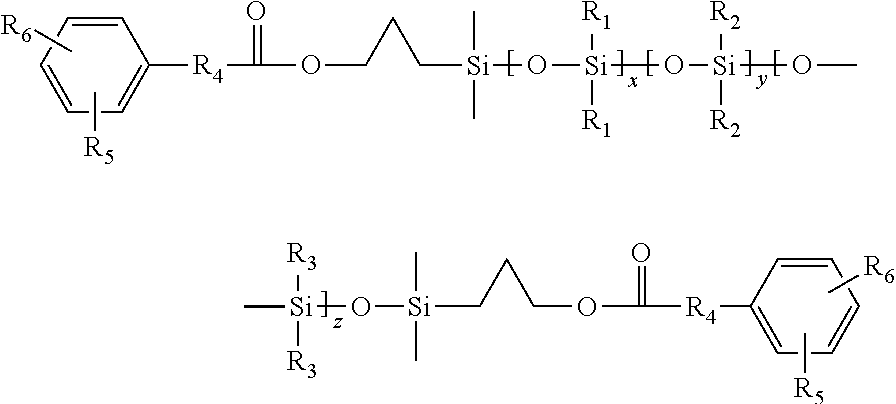Ester-functional polysiloxanes and copolymers made therefrom
a polysiloxane and functional technology, applied in the field of ester-functional polysiloxanes and copolymers made therefrom, can solve the problems of brittle polycarbonate, limited utility, and high likelihood of siloxane monomer hydrolysis after the reaction
- Summary
- Abstract
- Description
- Claims
- Application Information
AI Technical Summary
Benefits of technology
Problems solved by technology
Method used
Image
Examples
example 1
Synthesis of Hydride Terminated Siloxane Fluid HMD45MH
[0036]A mixture of octamethylcyclotetrasiloxane (D4) (500 g), and Purolite CT275 (2.298 g) were placed in a 500 ml RB flask equipped with a magnetic stirrer, a reflux condenser and stirred under nitrogen. To the stirred mixture, 1,1,3,3-tetramethyldisioloxane (HMMH)(19.68 g) was added at room temperature. The flask heated and held at about 50° C. for about one hour and then the temperature was increased to about 60° C. for about one hour. The temperature was then increased to 70° C. for about 2 hours and then increased to about 80° C. for about 4 hours. After completion of the reaction, the flask was cooled to less than 30° C., treated with Celite (0.750 g) and filtered. Volatiles were removed by applying a vacuum at 130° C. / 5 mbar to yield 480 g of clear colorless liquid. The liquid had the following characteristics: Solid content was 98%, Viscosity was 15-20 mPas, Hydride content was 11.68 cc H2 / g (0.0521 wt %), the Molecular ...
example 2
Synthesis of Phenol (Allyl-4-Hydroxy-Benzoate) Terminated Siloxane Fluid AHBMD45MAHB
[0037]A 250 ml RB flask was charged with HMD45MH (75 g, as prepared above) and alumina supported platinum catalyst (0.350 g) was stirred under notrogen and brought to 80° C. Allyl-4-((tetrahydro-2H-pyran-2-yl)oxy)benzoate (3,4-dihydro-2H-pyran protected phenol) (9.622 g) was charged into an addition funnel and added drop wise to maintain a reaction temperature less than about 100° C. Following the addition, the reaction mixture was brought to about 80° C. for 1 hour and then the temperature was increase to about 100° C. for about 2 hours. Completion of the hydrosilylation reaction was confirmed by proton NMR. The reaction mixture was allowed to cool to less than 30° C., treated with Celite (0.5 g) and filtered. Deprotection of phenol is done using THF / HCl mixture at 30° C. The resulting fluid was then stripped at 200° C. / 5 mbar to yield clear pale yellow liquid. The liquid had the following characte...
example 3
Synthesis of Phenol (Allyl-4-Hydroxyphenyl Acetate) Terminated Siloxane Fluid AHPAMD45MAHPA
[0038]Using the same reaction conditions in Example 1, allyl 2-(4-((tetrahydro-2H-pyran-2-yl)oxy)phenyl)acetate((3,4-dihydro-2H-pyran protected phenol allyl-4-hydroxyphenyl acetate) was used in the place of Allyl-4-((tetrahydro-2H-pyran-2-yl)oxy)benzoate (3,4-dihydro-2H-pyran protected phenol). The liquid had the following characteristics: Solid content was 98%, Viscosity was 127-140 mPas, the Molecular weight Mn was 4703, and the PDI was 1.7.
PUM
| Property | Measurement | Unit |
|---|---|---|
| Composition | aaaaa | aaaaa |
| Structure | aaaaa | aaaaa |
Abstract
Description
Claims
Application Information
 Login to View More
Login to View More - R&D
- Intellectual Property
- Life Sciences
- Materials
- Tech Scout
- Unparalleled Data Quality
- Higher Quality Content
- 60% Fewer Hallucinations
Browse by: Latest US Patents, China's latest patents, Technical Efficacy Thesaurus, Application Domain, Technology Topic, Popular Technical Reports.
© 2025 PatSnap. All rights reserved.Legal|Privacy policy|Modern Slavery Act Transparency Statement|Sitemap|About US| Contact US: help@patsnap.com



